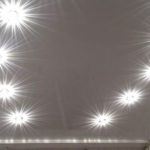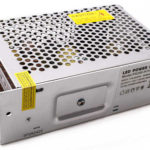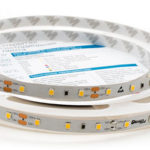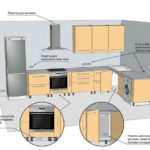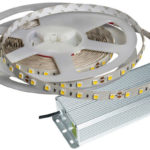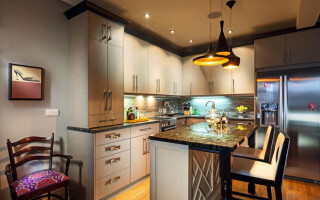A multilevel lighting system in the kitchen is the key to success. In other words, the kitchen should be divided into working areas. For example, areas for washing dishes, eating, places to work with food should be lit correctly, not by the principle of "the more, the better". Let's figure out how to create the right lighting for your work areas.
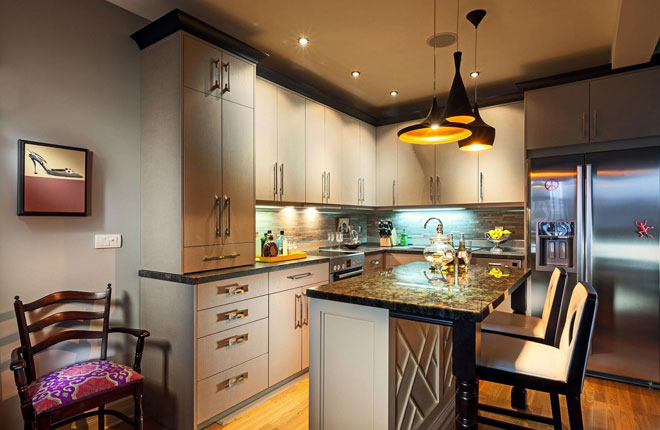
Contents
Requirements and standards for lighting in the kitchen
The first thing to do is make a layout diagram. Consider whether you want to visually expand the room or, conversely, reduce it and make it cozy.
This is not an easy task. Many factors will have to be taken into account:
- Do not allow for an overabundance and underabundance of light. An overabundance will glare. Lack will ruin your eyesight when handling groceries, for example.
- Choose the power of lighting fixtures wisely. If there are a lot of lights, their power should be less than if you had one lamp for the whole kitchen.
- The days of hanging light bulbs from the ceiling are over. Do not be afraid to experiment with LED strips, decorative lights.
- Observe the color balance. If the room is dark, the light reflection will not exceed 12-15%. Light colors reflect up to 80% of the light. This can be used to reflect the flow of light in the desired direction.
- Do not place electrical elements near water sources. The minimum distance is 600 mm.
- Recommended lighting power for food handling area is 100 W/m2. For dining area 40-50 W/m2.
Interesting! Sometimes the dining area is provided with lamps hanging over the table. If the size of the room allows you to place the lamp in this way, try it! It will create a cozy atmosphere in the room.
If you need accurate calculations, there is a formula to help you determine how much light your kitchen needs. Knowing that the minimum light level is 150 lux will help with the calculations.
We start from this value:
150 × м2 = required number of lumens in lighting fixtures.
Example Translating lux into lumens:
- The kitchen area is 20 m2.
- Multiply the minimum admissible illuminance by the area of the room and obtain the number of lumens.
- 150 × 20 = 3,000 lm.
Lumens are then converted to watts and the number of light bulbs is calculated according to their type incandescent, fluorescent, LED. There are hundreds of tables on the Internet with a detailed translation. Familiarizing yourself with them, you will find the optimal lighting fixtures in the right amount for the kitchen.
Organization of general lighting in the kitchen
When organizing the general lighting in the kitchen, you need to take into account its naturalness. For the room to be bright enough in the daytime, select translucent or transparent blinds or curtains.
But they are not recommended for ground-floor kitchens, where anyone passing by can see what's going on inside. So what should you do?
Multi-level ceilings are a good place to start. Using them, you will achieve the desired effect, if only because with their help you can hide the LED strip, to direct the light in the desired direction, or even divide the zones.

Creating a common light in the kitchen can be achieved by using classic chandeliers or stalking plafonds. A few tips:
- The former are recommended to install in kitchens with high ceilings, the latter - in small rooms.
- If the kitchen is long, the lamps or lamps can be installed in a single row. This is used to highlight, for example, dining areas.
- Downward facing lamps can only illuminate the space below them. If the ceiling is light, their rays are directed upwards. The light will be reflected, scattering across the room.
Work area lighting
The area where you work on cutting meat, vegetables, fruits, and other foods should be better lit than any other area of the kitchen. This is to prevent vision impairment and accidental cuts while working.
If you have a row of cabinets above your work area, this can be beaten to your advantage. Along the bottom of them, you can you could run a LED strip.which, incidentally, is the most affordable option. In addition, there are LED strips with a wall controller. It adjusts the brightness, modes, and colors. Choosing this type of lighting, you will sufficiently illuminate the surface to work.
But it is not recommended to overdo with the amount of light. No less disastrous will be the direction of the flow of light in the face. The rays should fall strictly on the work surface, NOT up, to the side or wall.
Interesting! Look online or in furniture stores for cabinets with built-in light boxes. This is an alternative to LED strip.
Another idea is to use the hinged lights we already mentioned. They're suitable for highlighting any area, whether it's a dining area or a place to work with groceries.
Dining area lighting
The eating area should in no case be lit brighter than the general space and the working area of the kitchen. Lighting is recommended to choose discreet, perhaps muted, so that it does not embarrass people sitting at the table and not cutting the eyes. But talk about what is right and what is not, must be supported by facts.
And here are a few rules, to observe which is not necessary, but in some cases they are indispensable:
- Take into account how the table is positioned in relation to the window openings;
- Try to use natural light as much as possible, setting the table closer to the windows;
- If it is not possible to install the table by the window, you can put it by the wall, illuminating it with a couple or three wall sconce lights.
For tables located in the center of the room hinged lamps and lamps with adjustable height are suitable. Such a variant combines with any size and peculiarities of the structure.
However, sconce lights and small kitchens are the golden mean, no matter what. There are also mini lamps and table type lights, which are installed directly on the surface of the table. But this comes at the expense of space on that very table.
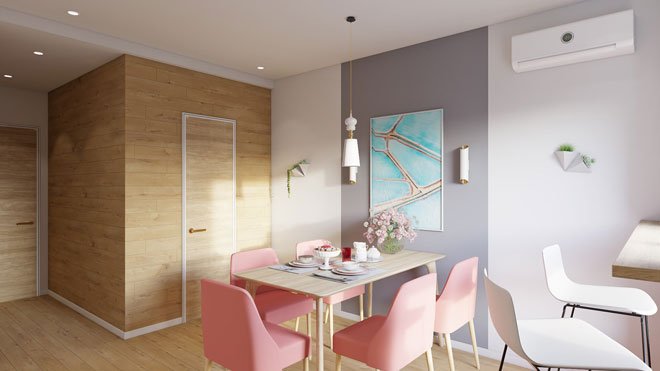
Backlighting for the stove or cooktop
Underlining stove in 95% of cases is not necessary because:
- General lighting is sufficient.
- Some cooktop models are backlit.
- The landlady or kitchen owner doesn't need stove lighting at all because the pots are already visible.
But if you need to equip the stove with lighting, we recommend turning to built-in lighting, which is installed on the hood. As a source of light, you choose spot mini lights or LED strip lights that frame the outline of the hood.
Interior lighting of kitchen cabinets
Sometimes kitchens do not have enough general light, nor point light. In this case, another type of lighting was invented - internal lighting of kitchen cabinets. Installing such an addition will make it easier to find the necessary condiments, ingredients or cutlery.
However, it is worth knowing that the functional tasks of the light will perform more in the lower and more recessed drawers and cabinets, rather than in those that are high on the walls.
The upper cabinets are equipped with LED lighting in case the owner of the kitchen wants to further decorate the room. It looks good inside those cabinets whose doors are glass or made of translucent materials. In some cases, such a combination even slightly visually increases the size of the kitchen.
There are no special rules for installing LED strips or spotlights. They are mounted on their own accord: put though at the top, though at the bottom, though attach it to the glass, if you wish.
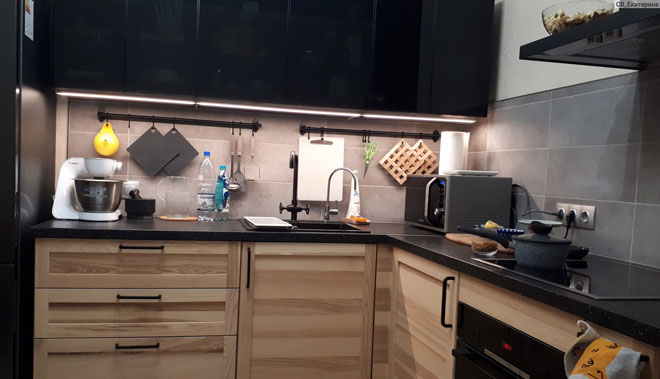
Decorative kitchen lighting ideas
Decorative kitchen lighting is the choice of those who want to create additional comfort in the room. This type of lighting does not play a role for the eating area or the food preparation area. It does not carry any load and has no installation rules, just like the installation of LEDs in the cabinets.
If you want, you can use an LED strip, designing a multi-level ceiling. Installing it between the kitchen set and the second level of the ceiling, we get a visually enlarged room. It looks especially effective in miniature kitchens, where there is no place for bulky pendant lights.
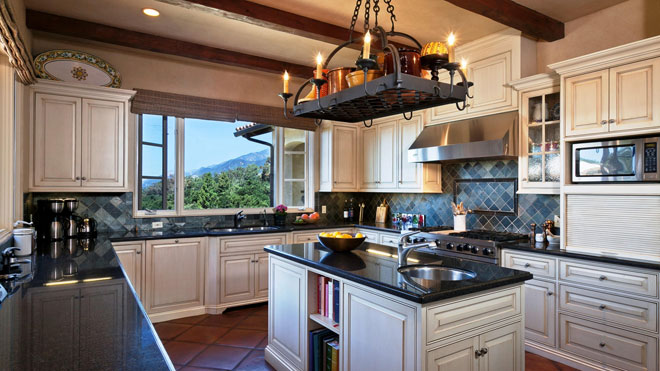
Another good option is framing the base of kitchen furniture along the perimeter LED strip or spotlights. This will give the impression that the framed pieces of furniture seem to float in the air. If there are paintings, they are also framed by the contour.
Dark and small kitchens are equipped with decorative sconces. They are placed on the wall in a row, using 2-3 pieces. Thanks to them, the kitchen is visually enlarged.
Kitchen studios are also divided by light. In a similar way, zones are highlighted and accents on places and household items are created. The dividers are:
- LED strips;
- strips of light embedded in the floor, walls, or ceiling;
- rows of suspended lights;
- rows of wall sconces;
- lighting of bar counters as space dividers.

